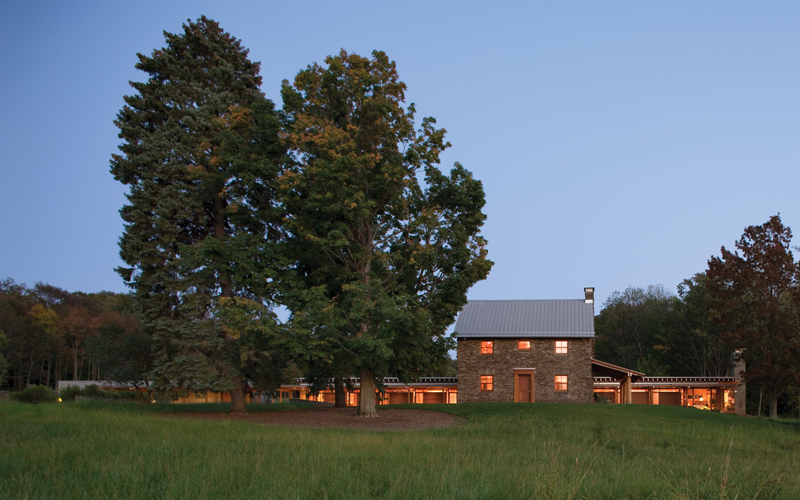Professional Practice
Increasing Energy Efficiency: Residential Tree Placement for Energy Efficiency
 The project reduces electricity costs for the house by leveraging shade from the site’s mature trees. ASLA 2010 Professional Residential Design Honor Award. Lily Lake Residence, Dalton, Pennsylvania / Michael Vergason Landscape Architects, Ltd.
The project reduces electricity costs for the house by leveraging shade from the site’s mature trees. ASLA 2010 Professional Residential Design Honor Award. Lily Lake Residence, Dalton, Pennsylvania / Michael Vergason Landscape Architects, Ltd. Homeowners can strategically plant trees on their property to increase the energy efficiency of their home. Shade trees can be sited optimally to provide building insulation and minimize heating and cooling costs.
Certain types of trees can provide seasonal benefits. For example, planting deciduous trees or vines on the western side of a home or building can provide cooling effects in the summer.
Tree planting organizations can help educate the public on the benefits, proper care, and maintenance of shade trees. Cities and local governments have programs to encourage residents to plant trees to improve a region’s canopy cover and help mitigate stormwater runoff. The city of Portland, Oregon, for example, has a seasonal program that incentivizes residents to plant yard trees that coincide with the appropriate time of year to plant trees. The resident receives a credit to their city water/sewage utility bill depending on the size of the tree and its stormwater management potential.
Sources: City Plants, City of Los Angeles tree-planting initiative
Organizations
Alliance for Community Trees
Arbor Day Foundation
Casey Trees
Human Dimensions of Urban Forestry and Urban Greening, College of Forest Resources, University of Washington
National Urban and Community Forestry Advisory Council
Yale University School of Forestry and Environmental Studies
American Forests
Tree Planting Programs
Treebate Program, City of Portland
Tree Incentive Program, City of Erie, Colorado
City Plants, City of Los Angeles
Request a Street Tree, NYC Parks
Resources
Treepedia: Compare Cities, MIT Sensible City Lab
Energy Saving Landscapes, Sustainable Urban Landscape Information Series, University of Minnesota
Free Shade Trees, Sacramento Municipal Utility District
Shade Tree Placement Tool, Sacramento Shade and Energy-Saving Trees Program
Landscaping Your Home for Energy Efficiency, Morton Arboretum
Trees and Home Energy Savings, Washington, D.C., Casey Trees
“The Sustainable Urban Forest: A Step-by-Step Approach,” Davey Institute / USDA Forest Service
Government Resources
Green Urban Design, City of Chicago
Landscaping, Energy Efficiency and Renewable Energy, U.S. Department of Energy
Trees and Vegetation, Heat Island Effect Resources, U.S. Environmental Protection Agency
Urban and Community Forestry, United States Forest Service
U.K. Forestry Commission
Research
"The Passive Solar House," James Kachadorian, Chelsea Green Publishing Company, 2006
“Handbook of Biophilic City Planning and Design,” Timothy Beatley, Island Press, 2016
Projects
Lily Lake Residence, Dalton, Pennsylvania
Michael Vergason Landscape Architects, Ltd.
Vineyard Retreat, Napa Valley, California
Scott Lewis Landscape Architecture